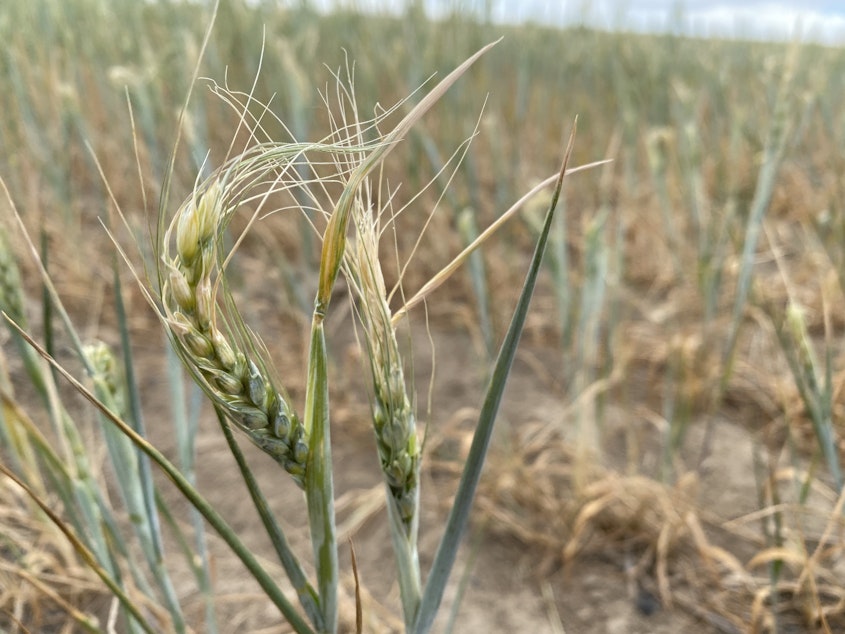No-till farming, cover crops reduce greenhouse gasses but cost growers at the start, study finds

When you think of heat-trapping greenhouse gas emissions, you might picture industrial smoke stacks or belching vehicle tailpipes. Turns out, farming also releases emissions that contribute to climate change.
“Agriculture is a tricky sector because a lot of these emissions, they’re not coming from energy usage. They’re coming from biogenic processes – things that are happening in the soil or in animals,” said Sarah Barrows, an economist at Pacific Northwest National Laboratory.
Tweaking some dryland farming practices in Eastern Washington could allow agriculture to help slow to climate change. However, those tweaks could initially cost growers a hefty amount of money, according to a preliminary study from Pacific Northwest National Laboratory.
“There’s not one solution that will work. It’s going to be a bunch of solutions that also have to make sense for the farmers,” Barrows said.
One of those solutions could be no-till farming, she said. However, on the middle range of the scale, implementing no-till farming could cost farmers $500,000 to $750,000, mostly because of equipment purchases.
“If you have a bigger farm, you'll have bigger revenues coming in, and it might be easier to pay off that chunk of capital cost that you have up front,” she said.
However, she said those upfront costs could be harder for smaller farms to cover. To help with the costs, growers could share equipment, she said, but that could be difficult if people needed to use equipment at the same time.
If farmers can get over that initial cost hump, the management changes pay out overtime from a reduction in labor, equipment and maintenance, she said.
Similarly, cover crops initially cost $28,000 to $38,000 for a midsized farm because the seed purchases and cultivation may cost more at the onset, Barrows said.
To help with startup costs, the Washington State Department of Agriculture is involved in several programs, including Sustainable Farms and Fields, a flexible grant that helps growers who implement conservation practices, said Dani Gelardi, senior soil scientist at the Washington State Department of Agriculture.
“Essentially, if a grower wants to reduce till, the program can help conservation districts purchase no-till drills, or if somebody wants to implement cover cropping, you can help them with cover cropping seed or help the conservation district hire consultants to provide workshops to teach people how to use cover crops,” Gelardi said.
Soon, she said, the department also will implement another program called STAR, which is short for Saving Tomorrow's Agricultural Resources, which will certify growers that use specific soil management practices, similar to certified organic products. The public and supply chain partners might pay more for crops grown with certified conservation practices, she said.
Growers have raised several concerns as they consider implementing some of these soil management practices, Gelardi said. For example, it’s hard for growers who get 12 inches of rain a year to consider adding a cover crop, which would need some of that water.“There's nothing coming in from the sky, and perhaps you need that moisture to plant your wheat in the fall,” she said.
However, she said, overtime cover crops could increase moisture retention in soil.
“So in years, let's say one, two or three, you're giving up water to the cover crop, but the cover crop can eventually increase soil organic matter, and therefore, water holding capacity,” Gelardi said. “But not every farmer can wait three years for that payoff. And, honestly, in some conditions, that payoff might not come at all.”
Growers also raised concerns about temperature, climate and economics, including the cost of implementing no-till practices for small farms.
Increasingly, she said, the public would like agriculture to become part of the climate solution. One way to do that is through cover crops, she said, which can help sequester carbon.
To grow, plants remove carbon dioxide, a heat-trapping greenhouse gas, from the atmosphere. That carbon is stored inside the plant and can flow into the soil through the plant’s roots and when plants decompose, Gelardi said.
Cover crops also help hold soil in place, she said. Bare fields can allow soil to blow away with wind or wash away during heavy rains.
“The top six to 12 inches of the soil is really where a lot of soil carbon is. It's the most biologically active part of the soil and holds a lot of that carbon,” Gelardi said. “So, if we're losing that to rain and to wind, that's a big loss both in terms of soil carbon and in terms of fertility for the farmer.”
In the United States, agricultural practices made up roughly 11% of total greenhouse gas emissions in 2020, according to the Environmental Protection Agency. Since 1990, emissions from agriculture have increased by around 6%, mostly due to livestock manure management systems.
Agriculture produces the majority of nitrous oxide emissions in the United States, according to the EPA. Nitrous oxide, more commonly known as laughing gas, is a potent greenhouse gas that also depletes the ozone layer. As a greenhouse gas, nitrous oxide is 300 times more powerful than carbon dioxide.
The preliminary study at Pacific Northwest National Laboratory found various changes in agricultural practices in Eastern Washington reduced carbon emissions but didn’t significantly affect nitrous oxide emissions.
Because not every soil management practice works for every farm, more scientists need to further study various soil management practices for specific areas, Barrows said.
In addition, a longer-term study over five or 10 years would provide more insight into the costs for different farms, said Abigail King, a post-master's research associate at Pacific Northwest National Laboratory.
“We hypothesize that a lot of the benefits will increase over time,” King said. “It’s going to take time for the land to adjust, for the crops to adjust to a change in practice.” [Copyright 2022 Northwest News Network]
